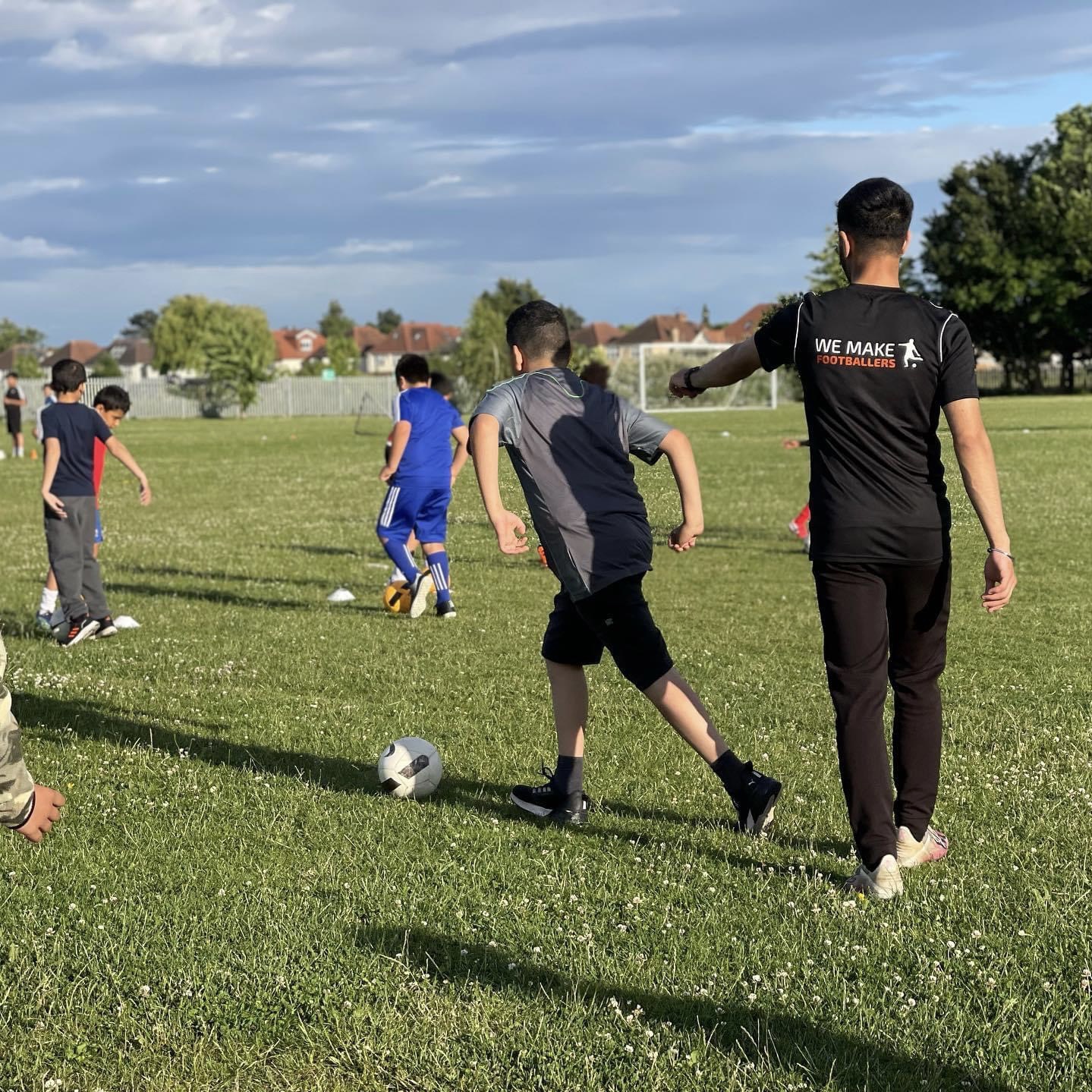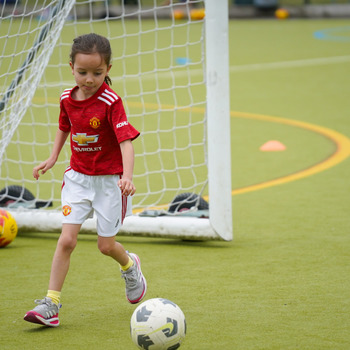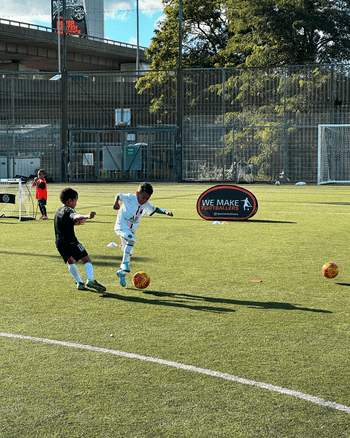THE POWER OF VISUALISATION:
HARNESSING YOUR CHILD’S IMAGINATION AND USING IT ON THE FOOTBALL PITCH
Who does your child pretend to be when they are playing football down the park or in the garden? Do they try and dribble like Lionel Messi? Take free-kicks like Cristiano Ronaldo? Finish clinically like Jamie Vardy?
 Whoever they try and emulate, a child’s imagination can be a powerful tool to help them improve as a football player. This is known as the power of visualisation - and it is a method of training which We Make Footballers are always looking to explore with young players in our academies.
Whoever they try and emulate, a child’s imagination can be a powerful tool to help them improve as a football player. This is known as the power of visualisation - and it is a method of training which We Make Footballers are always looking to explore with young players in our academies.
Two of the most famous moments in English sporting history both owe their happenings to the power of visualisation, offering just a couple of examples of great sportspeople who have taken full advantage of this underrated method of training.
Cast your mind back to Saturday 6th October 2001. England has a free kick in the final seconds of their last World Cup Qualifier against Greece at Old Trafford. If David Beckham scores, the Three Lions are guaranteed a place in Japan and South Korea. If he doesn’t, then they enter the lottery of the playoffs. Everyone knows what happened next. Beckham stepped up and bent a perfect effort up and over the Greek wall to score one of the most famous goals of all time.
It did not happen by accident. Beckham was a ferocious worker on the training ground and famously practised his free-kicks for hours after official training had finished. He was also a believer in the power of visualisation. Ever since he was a child, he had visualised captaining England and having the responsibility of such pressure moments on his shoulders. Beckham was more prepared than anybody else in the world to deliver England’s place at the World Cup because he had lived it in his mind countless times over many years. That is the power of visualisation.
Fast forward a little over two years to Saturday 22nd November 2003. England is playing Australia in Sydney in the Rugby World Cup final. The scores are locked at 17-17 in the final seconds of extra time.
Suddenly, the ball gets worked to Jonny Wilkinson in enough space to go for a drop goal. If he gets it over the posts, England will defeat the hosts and become world champions.
Just like Beckham in football, Wilkinson had spent his life visualising the moment he could win a World Cup for England. And just like Beckham in football, he did not miss. England win 20-17 and history is again made.
In his autobiography, Wilkinson talked about how he was supremely confident when the opportunity presented itself because of how often he had imagined it. There were no nerves because his mind and body had been there so many times before that it no longer felt like a nervous situation – instead, there was only self-belief.
“If you have realistically imagined situations, you feel better prepared and less fearful of the unexpected,” Wilkinson wrote. The Power of visualisation is summed up in a sentence.
Beckham and Wilkinson had practised the power of visualisation from a young age, without even realising it. Every child who imagines themselves getting that goal for Manchester United or Arsenal in the FA Cup Final is doing the same thing – as are those who recreate Harry Kane scoring against Germany in the Euro 2020 knockout stages.
We Make Footballers believe that both these types of visualisations – a child imagining themselves succeeding or visualising themselves as their hero – can help improve a player beyond what happens on the training pitch.
If a child wants to be Messi, then the best way to do that is by watching the compilations of his play. Mimic his dribbling action and style and a child will run the ball with their heads up. They will have learnt an important technical aspect of the game through their visualising of being Messi.
The same goes for those who copy the sweet spot of the ball Ronaldo strikes when taking a free-kick. Or the way that Vardy and Kane always look at where they are placing their shots, rather than down at the ball.
 A child visualising themselves succeeding can be even more powerful. Whereas adults tend to be more cynical, children have less fear of failure and are more willing to believe that anything is possible.
A child visualising themselves succeeding can be even more powerful. Whereas adults tend to be more cynical, children have less fear of failure and are more willing to believe that anything is possible.
This makes it easier for them to imagine themselves in scenarios like scoring goals for England in the future. In the present, if you ask a child to visualise a task such as finishing with their weaker foot or Cruyff Turning away from an opponent and then it leads to success, they understand the power of visualisation and will keep utilising it.
That is what happened to no lesser player than Wayne Rooney. England’s record goalscorer – until Kane overtakes him at least - scored so many throughout his career because he visualised success before every game he ever played, going right back to when he was a child in Liverpool.
“I lie in bed the night before the game and visualise myself scoring goals or doing well,” Rooney said in an interview during his time at Manchester United.
“You’re trying to put yourself in that moment and trying to prepare yourself, to have a ‘memory’ before the game. I don’t know if you’d call it visualising or dreaming, but I’ve always done it, my whole life.”
Rooney, Beckham and Wilkinson are not the only advocates for the power of visualisation. It is backed up by science too, with a 1980s study carried out by the US Olympic Team claiming that visualisation can be as effective as actual practice.
Athletes were asked to visualise running their race and hooked up to a machine to measure the response of their bodies. It was discovered that the same muscles fired in the same sequence when visualisation took place as they would have done on the track.
The visualisation could therefore be used to train the muscles and brain in a similar way to physically carrying out the activity, hardwiring muscle memory with the sequence needed for success and speeding up reaction times.
Training is suddenly no longer restricted to an hour a day. The power of visualisation means that practice can take place in the car, after dinner, on the walk to school or if you are Rooney, whilst lying in bed at night.
Visualisation takes no physical toll on the body. Not only does that mean that extra training can take place without impacting on rest times, but it also allows injured players to keep practising and remain connected with the game.
The imagination of a child is one of their most powerful tools. What visualisation does is harness that power and use it to develop confidence, self-belief and improve footballing ability beyond what is possible through mere training on the pitch – something that We Make Footballers explore with the children in our academies.



